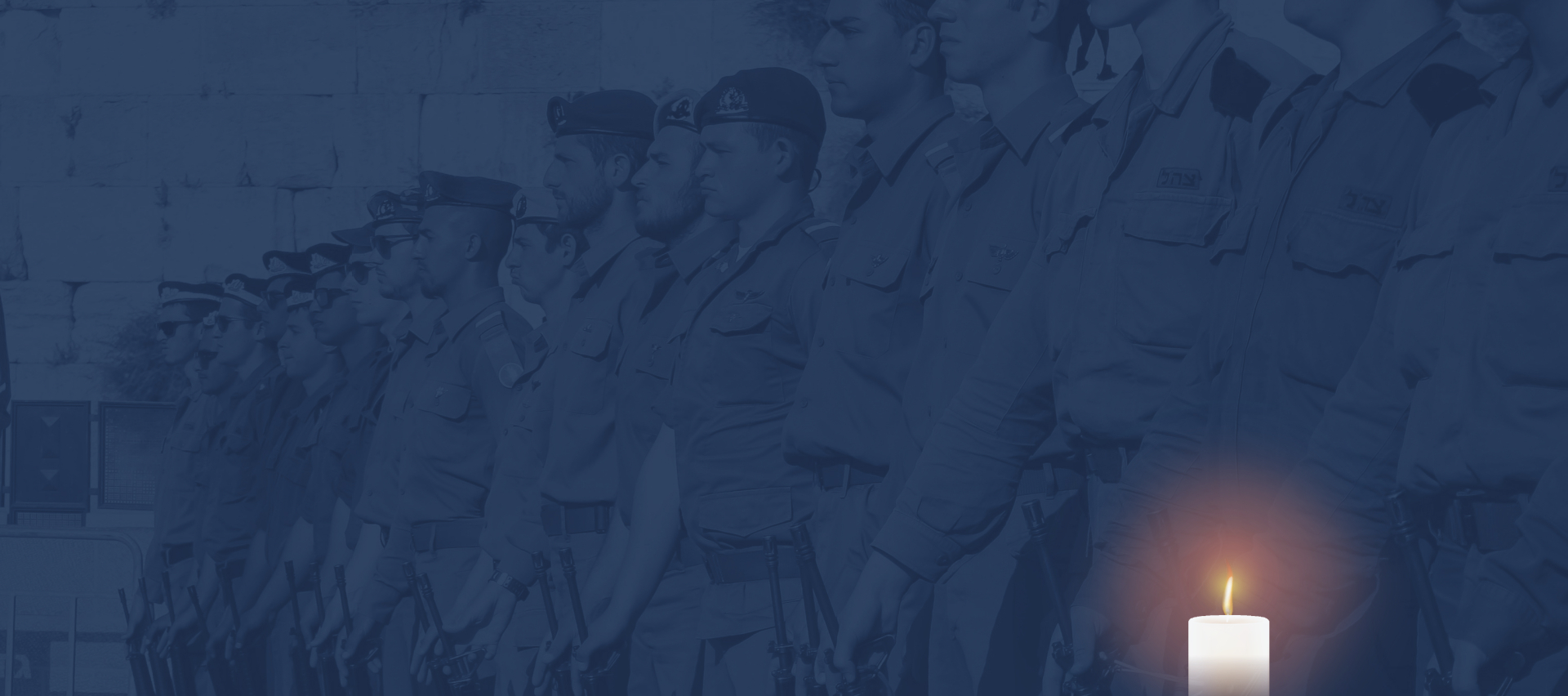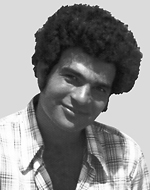,אֵ-ל מָלֵא רַחֲמִים, שׁוכֵן בַּמְּרומִים, הַמְצֵא מְנוּחָה נְכונָה
,עַל כַּנְפֵי הַשְּׁכִינָה בְּמַעֲלות קְדושִׁים, טְהורִים וְגִבּורִים
כְּזֹהַר הָרָקִיעַ מַזְהִירִים, לְנִשְׁמות חַיָּלֵי צְבָא הֲגָנָה לְיִשְׂרָאֵל



David, Ze’ev (Zafi)
Shulamit and Haim’s third son. He was born on the 5th of Tevet 5711 (5.1.1951) in Kiryat Yam. Brother to Dina, Yair and Doron. Ze’ev was named after his father-in-law, Willy-Ze’ev David, who was one of the founders of Nahariya and died in October 1950, a few months before the birth of his grandson. He did not get to know his grandmother, Elsa David, because she was murdered by Arab rioters in the events of 1939 when the bus she was traveling in was attacked by gunfire from an ambush. Grandmother Elsa, mother of seven, was killed on the spot. Ze’ev was called Zafi from his infancy until his death. He was a curly baby, cute, smiling and very much loved by everyone. As a baby breastfed, he had a rare allergy to late-tested breast milk. When Zafi was a year old, his family joined Kibbutz Gvaram in the wake of his uncle, his mother’s brother Gideon Salafad, who was among his founders. The kibbutz was young then, and in the kindergarten there were a handful of children who were divided into two groups, young and old. The graduates went through thorough preparation to the school and went directly to the second grade. Zafi belonged to the group of young people and therefore did not take part in the preparations, but at the beginning of the school year a number of families with children from the group of graduates left the kibbutz, and Zafi went to school immediately, despite his young age and without preparation. This made his adjustment difficult, but gradually he found his place in class and in school. Around the same time, when Tzafi was six years old, his brother Doron was born. Until the 10th grade, Zafi studied at the school in Giboram and in grades 11-12 he continued in Shaar Hanegev High School. In 1969, when Zafi was eighteen, he was orphaned by his father, Haim. Zafi was a very sociable person and loved everyone even in his adulthood. He liked to work in the garage, play chess and soccer, and was an enthusiastic fan of Hapoel Tel Aviv – and in all its games. When he reached the army, he chose the Armored Corps, became an outstanding commander of the Centurion tank and served in the Golan Heights in the 7th Brigade. After his discharge from the regular army service, Zafi returned to Kibbutz Gvaram and worked in the garage. In October 1973, when the Yom Kippur War broke out, Zafi planned to marry Shulamit his girlfriend. The wedding date had already been set, but Zafi went to the front to fight the northern Suez Canal. He was recruited and stationed at the Tse’elim base, where his team was composed of reservists who had been discharged from regular service a short time before. Zafi was the tank commander, Shmuel Haim Rotfeld – Ta’ash Kachar, Meir Kihan – an artillery officer and another reservist who served as a driver. The crew did not know each other before, except for Haim and Meir, both of them Nachalim, graduates of the hesder yeshiva, who were converted to armor. “The Steel Formation” The crew wanted to reach the front with the euphoria of the Six-Day War, but later realized that the war was difficult and that there were many casualties: “Do not sleep on the side of the tank, “On his way, the tank prize crawled twice, the second deployment was near Romney, in the northern sector of the Sinai front, and a crew under the command of a munitions officer from the Belusa Sy The tank crew called themselves “the lone tank” and it is not clear which framework they fought in, although from the moment they reached the front, they fought continuously in the sands of Sinai, in the battle of containment The crew fired shells and hit many Egyptian tanks, and at least twice the tank was emptied of shells and forced to go back for refilling, and the operation was so intensive that Meyer and Chaim found it difficult to find a suitable time for prayer. The tank created a good, friendly, harmonious atmosphere, and an efficient teamwork was conducted: Haim claimedKachar would report when there was a shell in the barrel of the cannon, the commander, Ze’ev (Zafi), was aiming at the target and the gunner would shoot. Life took place throughout the fighting in the tank, the crew slept in the tank, and the conversations between them focused on operational issues. Ze’ev held motivational and team conversations, supervised matters and gave guard duty. During the battles he also praised Chaim Rotfeld, who was responsible and kept order and cleanliness in the tank, as well as gunman Meir Kehan. The crew accepted his authority as the tank commander without question and followed his words, even though they had not known him before. During the fighting in the field, the “lone tank” crew often heard the exits of RPGs and saw them pass over them. They saw damaged tanks of our forces as well as Israeli Air Force planes, when they were hit and killed. In one case, they identified an air-to-air missile fired at a Phantom jet and dropped it. On Thursday, October 18, Simchat Torah holiday and three days before the scheduled date for Zafi’s wedding, after a day of heavy fighting, the tank engine “threw” oil and therefore drove for about an hour to attend the workshop in Beluzah. While the men in the workshop took care of the tank, Zafi, the motivated commander, urged them to hurry and use it so that they would be allowed to return as soon as possible. In the meantime, Zafi went out to smoke outside the tank, a young man on his cheeks and shoulders wrapped in a prayer shawl, a habit a kibbutznik was not used to. At six in the evening, when it was dark outside and the engine was being re-installed in the tank, the crew was ordered to enter the tank due to information about Egyptian forces that had been dropped from helicopters nearby and started firing mortar shells at the workshop. But as they entered the tank, a mortar shell hit the arm of the crane that carried the engine from the rear deck of the tank and exploded. The fragments of the bomb flew in all directions. The tanker, Shmuel Haim Rotfeld, who was on his way to the tank, was killed on the spot and Zafi, the tank commander, who was waiting to enter him, was wounded by shrapnel, slightly above his left foot. Another officer was killed and another soldier was wounded by the same volley, and then the gunman Meir Kihan began helping Zafi. And asked the man to sit next to the tank and then proceeded to the first treatment for the wounded man next to the tank, and then Zafi was evacuated to the nearby victims’ station in Beloza, across the road from where he was transferred to Rafidim and rushed to Hadassah Hospital in Jerusalem. His leg was due to the decay that had developed in it, and when Zafi’s condition improved, his marriage ceremony was held with Lee’s choice And in the synagogue of Hadassah Hospital, the father of the injured, Simcha Holtzberg, who returned home to the kibbutz as a disabled person, but his recovery from the injury was swift and he again became involved in the act. His second son Shachar was born and his youngest son Lior was born in 1980. On the eve of Rosh Hashana 5743 (17.9.1982), the medical condition of First Sergeant Ze’ev (Zafi) David, Him and he died. He was thirty-one years old at the time of his death. He was laid to rest in the cemetery at Kibbutz Gvaram. He left behind a wife, three sons, a mother, a sister and two brothers

